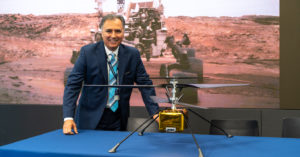This Company Is Helping To Put A Helicopter On Mars—And You Could Help was originally published on WayUp.
If you’re interested in aerospace engineering, getting one of your creations to outer space is probably a lifelong dream of yours. The good news is that you could accomplish that way sooner than you probably think.
While getting something to Mars might seem like a stretch goal during your undergrad years, at AeroVironment—a specialized technology firm that collaborates with organizations like NASA and the US military—this is exactly the kind of project you could work on, even as an intern.
We spoke to two AeroVironment engineers, Sara and Benjamin, who gave us an inside look at this exciting project and the company’s unique culture.
The AeroVironment-NASA Collaboration And The Mars Helicopter
AeroVironment was started by world renowned inventor and engineer, Dr. Paul B. MacCready, Jr. in 1971 as a small engineering firm focused on applying aerodynamic principles to solve important challenges facing the world. He became the first to design and build an aircraft that successfully achieved controlled human-powered flight, giving birth to the company’s reputation of achieving the impossible in aerospace engineering. In fact, one of AeroVironment’s first projects was the Gossamer Condor, which was operated with pedals—like a bike—and now rests in the National Air and Space Museum.
That spirit of innovation and unorthodox thinking led AeroVironment to become experts on unique technologies, and the leader in tactical unmanned aircraft systems (aka drones) and tactical missile systems. One of these experts is Benjamin, a Senior Aeromechanical Engineer, who works on the Mars Helicopter.
So, what can he tell us about this ambitious project?
“AeroVironment first worked with JPL [Jet Propulsion Lab, a federally funded wing of NASA] on this in the late 1990s, but the technology wasn’t quite there yet,” Benjamin tells us. “Around a decade later in 2013, JPL came back to us and asked us to start working with them on it again. Our goal was to develop a helicopter that could tag along with the next Mars Rover mission to demonstrate that helicopters can be useful in that type of environment.”
Unlike a normal helicopter, which relies on the specific conditions of Earth’s gravity and atmosphere to achieve lift, the Mars Helicopter needs to have huge wings and an extremely light body in order to fly. Plus, it has to be capable of carrying a camera so they can use it to collect images and scientific data.
“The Mars Rover, called Perseverance, launched on July 30, 2020. The helicopter onboard is called Ingenuity,” Benjamin says. “If its mission is successful, we’ll be looking into larger helicopters that could also collect interesting scientific data on other planets.”
That means everyone at AeroVironment—and one day, possibly, you—will have a lot more exciting projects to grapple with. And as another engineer on the team, Sara, tells us, when you’re on the AeroVironment team, your work really is a part of the final product.
Working At AeroVironment Means Taking On A Real Role, Right Away
“Even when I was an intern, I loved the culture of being hands on, getting to try things and test things and see what works,” Sara, an Aeromechanical Engineer, says. “Now that I’m a full-time Aeromechanical Engineer, I still do. I do a little bit of everything: some design work and some building.”
AeroVironment’s project teams, which work on products ranging from commercial and military-grade unmanned aircraft to moonshot technologies like the Mars Helicopter, are comprised of small groups of multifaceted engineers and technologists at all levels of seniority.
“We have the resources of a larger company, but the culture of a smaller one,” Sara explains.
Thanks to this structure, which is fairly unique in the world of aerospace, everyone on the team is able to come up with ideas, test them out, and contribute to the final product that makes it into the field.
“Honestly, I have fun at work. We get to play in the shop. We get to be really innovative and creative with the things we’re building. We’re given a lot of freedom to try things and prototype and I really enjoy that aspect of our programs. I really like that rapid prototyping and rapid R&D. If we have an idea, we can just try it.”
Sara, Aeromechanical Engineer at AeroVironment
Whether you’re working on planetary exploration or innovating in the shop, at AeroVironment, opportunities to make history—and an amazing career—are always close at hand.
Want to start your career in aerospace and technology? Check out open opportunities at AeroVironment on WayUp!
The post This Company Is Helping To Put A Helicopter On Mars—And You Could Help appeared first on Job and Internship Advice, Companies to Work for and More | WayUp Blog.


